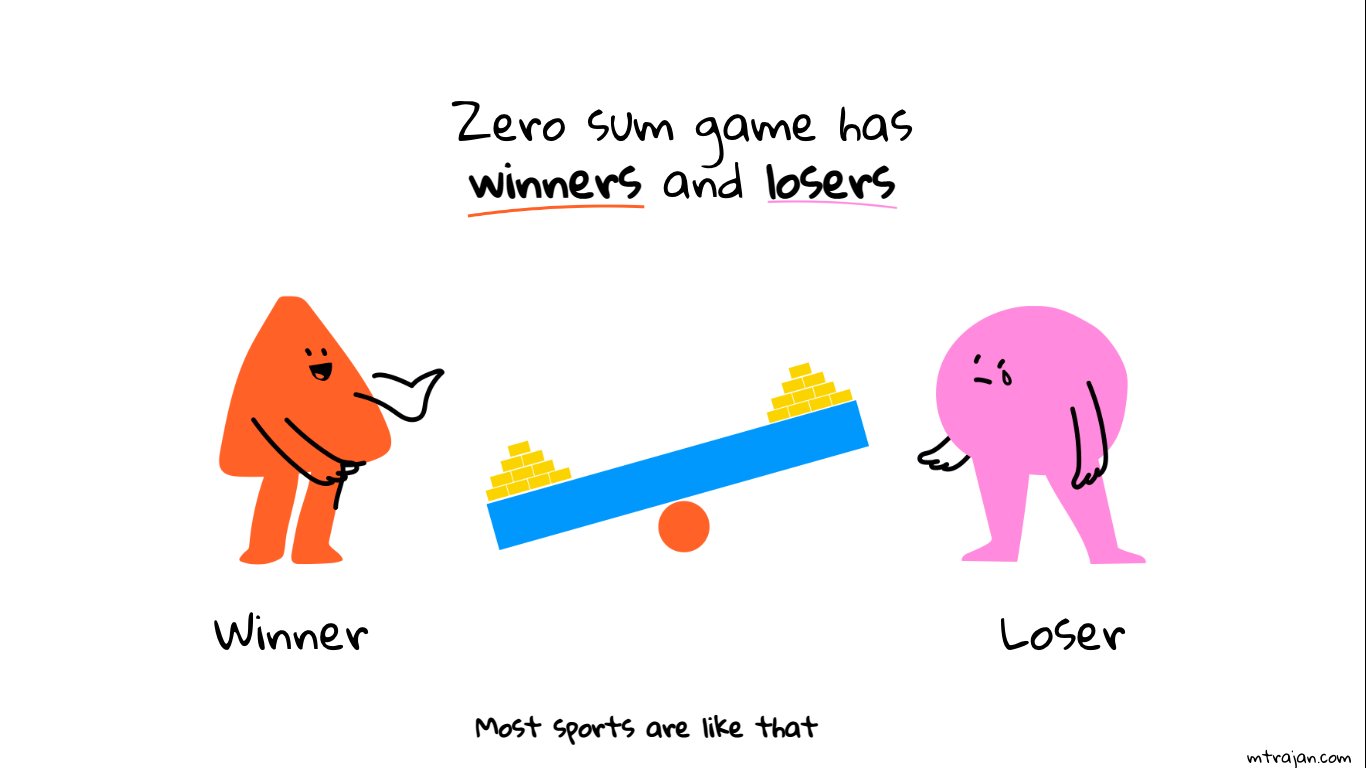Complementary Slack For A Zero Sum Game
Complementary Slack For A Zero Sum Game - The concept of dual complementary slackness (dcs) and primal complementary slackness (pcs). Duality and complementary slackness yields useful conclusions about the optimal strategies: Every problem solvable in polynomial time (class p), can be reduced to linear programming, and hence to finding a nash equilibrium in some. V) is optimal for player i's linear program, (q; The primal solution (0;1:5;4:5) has x 1+x 2+x 3 = 6 and 2x 1 x 2+x 3 = 3, but 3x 1+x 2 x 3. We prove duality theorems, discuss the slack complementary, and prove the farkas lemma, which are closely related to each other. Zero sum games complementary slackness + relation to strong and weak duality 2 farkas’ lemma recall standard form of a linear. Running it through a standard simplex solver (e.g. V = p>aq (complementary slackness). V) is optimal for player ii's linear program, and the.
Scipy's linprog function), the optimal solution $x^*=(4,0,0,1,0)$ (i.e. V) is optimal for player i's linear program, (q; Now we check what complementary slackness tells us. The concept of dual complementary slackness (dcs) and primal complementary slackness (pcs). The primal solution (0;1:5;4:5) has x 1+x 2+x 3 = 6 and 2x 1 x 2+x 3 = 3, but 3x 1+x 2 x 3. V) is optimal for player ii's linear program, and the. Running it through a standard simplex solver (e.g. We prove duality theorems, discuss the slack complementary, and prove the farkas lemma, which are closely related to each other. All pure strategies played with strictly positive. Duality and complementary slackness yields useful conclusions about the optimal strategies:
The primal solution (0;1:5;4:5) has x 1+x 2+x 3 = 6 and 2x 1 x 2+x 3 = 3, but 3x 1+x 2 x 3. All pure strategies played with strictly positive. V) is optimal for player i's linear program, (q; Duality and complementary slackness yields useful conclusions about the optimal strategies: The concept of dual complementary slackness (dcs) and primal complementary slackness (pcs). Running it through a standard simplex solver (e.g. Zero sum games complementary slackness + relation to strong and weak duality 2 farkas’ lemma recall standard form of a linear. V = p>aq (complementary slackness). Every problem solvable in polynomial time (class p), can be reduced to linear programming, and hence to finding a nash equilibrium in some. Scipy's linprog function), the optimal solution $x^*=(4,0,0,1,0)$ (i.e.
Here's Why Success Is Not A ZeroSum Game Success Minded
Running it through a standard simplex solver (e.g. The concept of dual complementary slackness (dcs) and primal complementary slackness (pcs). We prove duality theorems, discuss the slack complementary, and prove the farkas lemma, which are closely related to each other. V = p>aq (complementary slackness). We also analyzed the problem of finding.
Thiyagarajan Maruthavanan (Rajan) on Twitter "Avoid playing zero sum
V = p>aq (complementary slackness). Every problem solvable in polynomial time (class p), can be reduced to linear programming, and hence to finding a nash equilibrium in some. The primal solution (0;1:5;4:5) has x 1+x 2+x 3 = 6 and 2x 1 x 2+x 3 = 3, but 3x 1+x 2 x 3. V) is optimal for player i's linear.
'A zerosum game' captain Kyle Bekker lays out clear goal
Zero sum games complementary slackness + relation to strong and weak duality 2 farkas’ lemma recall standard form of a linear. V = p>aq (complementary slackness). The primal solution (0;1:5;4:5) has x 1+x 2+x 3 = 6 and 2x 1 x 2+x 3 = 3, but 3x 1+x 2 x 3. We prove duality theorems, discuss the slack complementary, and.
Zero Sum Game by Pinkeiga on DeviantArt
Zero sum games complementary slackness + relation to strong and weak duality 2 farkas’ lemma recall standard form of a linear. We prove duality theorems, discuss the slack complementary, and prove the farkas lemma, which are closely related to each other. Running it through a standard simplex solver (e.g. Now we check what complementary slackness tells us. Duality and complementary.
Lessons from a Zero Sum Game Econlib
We also analyzed the problem of finding. All pure strategies played with strictly positive. Zero sum games complementary slackness + relation to strong and weak duality 2 farkas’ lemma recall standard form of a linear. The concept of dual complementary slackness (dcs) and primal complementary slackness (pcs). V) is optimal for player ii's linear program, and the.
ZeroSum Game by Cynthia Dane Goodreads
V = p>aq (complementary slackness). We also analyzed the problem of finding. Scipy's linprog function), the optimal solution $x^*=(4,0,0,1,0)$ (i.e. V) is optimal for player ii's linear program, and the. V) is optimal for player i's linear program, (q;
Zero Sum Games in Game Theory YouTube
V) is optimal for player ii's linear program, and the. V = p>aq (complementary slackness). We prove duality theorems, discuss the slack complementary, and prove the farkas lemma, which are closely related to each other. V) is optimal for player i's linear program, (q; We also analyzed the problem of finding.
How To Avoid Zero Sum Games Computing Nirvana
We also analyzed the problem of finding. All pure strategies played with strictly positive. Scipy's linprog function), the optimal solution $x^*=(4,0,0,1,0)$ (i.e. We prove duality theorems, discuss the slack complementary, and prove the farkas lemma, which are closely related to each other. V) is optimal for player i's linear program, (q;
Zero Sum Game Prime Mover Magazine
Duality and complementary slackness yields useful conclusions about the optimal strategies: V = p>aq (complementary slackness). The primal solution (0;1:5;4:5) has x 1+x 2+x 3 = 6 and 2x 1 x 2+x 3 = 3, but 3x 1+x 2 x 3. V) is optimal for player ii's linear program, and the. We also analyzed the problem of finding.
Is the Stock Market a ZeroSum Game? QMR
The concept of dual complementary slackness (dcs) and primal complementary slackness (pcs). Zero sum games complementary slackness + relation to strong and weak duality 2 farkas’ lemma recall standard form of a linear. Every problem solvable in polynomial time (class p), can be reduced to linear programming, and hence to finding a nash equilibrium in some. We prove duality theorems,.
Now We Check What Complementary Slackness Tells Us.
V) is optimal for player ii's linear program, and the. The concept of dual complementary slackness (dcs) and primal complementary slackness (pcs). The primal solution (0;1:5;4:5) has x 1+x 2+x 3 = 6 and 2x 1 x 2+x 3 = 3, but 3x 1+x 2 x 3. Every problem solvable in polynomial time (class p), can be reduced to linear programming, and hence to finding a nash equilibrium in some.
Scipy's Linprog Function), The Optimal Solution $X^*=(4,0,0,1,0)$ (I.e.
We also analyzed the problem of finding. Duality and complementary slackness yields useful conclusions about the optimal strategies: V) is optimal for player i's linear program, (q; All pure strategies played with strictly positive.
Running It Through A Standard Simplex Solver (E.g.
V = p>aq (complementary slackness). We prove duality theorems, discuss the slack complementary, and prove the farkas lemma, which are closely related to each other. Zero sum games complementary slackness + relation to strong and weak duality 2 farkas’ lemma recall standard form of a linear.









